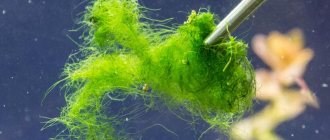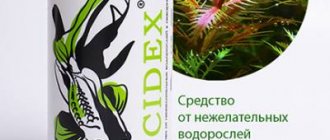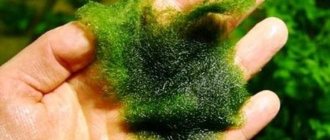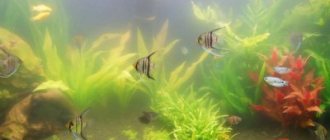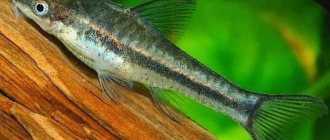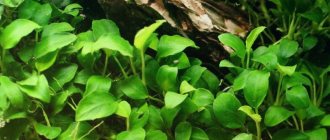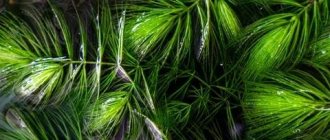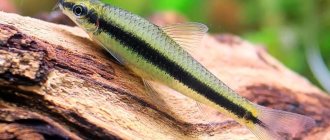Brown algae belong to the group Diatomaceae or Diatoms. Although there is a species called “Brown algae” in the group of Diatoms, only marine plants are included there (for example, sea palm, kelp - sea kale). And when it comes to aquarium algae, brown is just a color. They are also called brown, red or yellow.
The Diatom trait is considered to be the ability to absorb and process any organic matter. This is why brown algae grows so rapidly in water. Most often, the main reason for the appearance of Diatoms is an excess of ammonia or nitrogenous compounds in the water, which are harmful to underwater inhabitants.
Brown algae is a problem that many aquarists have encountered, and not just beginners. The formation of diatoms in an aquarium indicates a violation of the biosystem of the tank with underwater inhabitants.
A brown coating suddenly appears in the aquarium and affects plants, stones and walls. If brown algae in an aquarium is not dealt with, then within a few days they infect the entire tank and lead to the death of vegetation. And it will take a couple of weeks or months to get rid of it. Therefore, it is better to know in advance about the reasons for the appearance and methods of combating brown algae in the aquarium.
Reasons for appearance
You can find out about the appearance of Diatoms in the tank by the first and main symptom - a brown or yellow coating formed on the vegetation. The first symptoms are the formation of light dust or turbidity in the water, which is barely noticeable. At the initial stage, the plaque is easily erased and raises dust if it is shaken off. If Diatoms are not noticed, then over time the layers grow on top of each other. The color changes from brown to black. The top layer is also easy to remove, but older layers are more difficult to remove. The transparency of the aquarium glass is greatly reduced.
There are several reasons for the appearance of brown plaque in an aquarium and they depend not only on care, but also on the age of the microflora of the aquarium.
In a young tank started less than 3-4 months ago, the appearance of brown algae in the aquarium is common. In this container, living plants have only recently been planted, they have not yet had time to take root and begin to absorb substances from the water. At this time, nothing prevents Diatoms from actively reproducing.
The correct nitrogen cycle is also not established in a young aquarium. Leftover food and fish waste products begin to rot and decompose much faster. This environment is favorable for the reproduction of brown diatoms.
More often than not, in a young tank the acidity of the water is low, usually the water is alkaline or neutral. With such water levels, plants and microorganisms are not able to assimilate many compounds. If the acidity is above 7pH, then the water will have a high concentration of ammonia, which Diatoms feed on. And with an acidity below 7 pH, the water contains enough ammonium, which is consumed by underwater plants.
If a brown coating appears on plants and walls in a well-functioning and long-running aquarium, then the main reason is the accumulation of organic substances in the soil and water, which turn into ammonia.
Incorrect operation of the filter also leads to the appearance of brown deposits. If the filter is clogged or missing altogether, the water is not purified. This leads to the accumulation of organic matter.
Fertilizer application is also not always beneficial. Fertilizers are a source of ammonia, which algae need. If you apply a lot of fertilizers, the plants do not have time to absorb them. A young aquarium does not require additional fertilizers other than potassium in small doses.
Low water temperatures of 16–21 degrees accelerate the development of brown algae.
The main reason for the appearance of algae is improper care and infrequent cleaning of the aquarium. If you do not change some of the water weekly and do not wash the aquarium every few weeks, then food particles remain on the walls and in the soil, which subsequently decompose.
If a brown coating appears on the plants, then a possible reason is a high concentration of iodine. Iodine is used to treat certain fish diseases. If the treatment took place in a common aquarium and was repeated, then iodine accumulates in the water and causes the proliferation of diatoms. Iodine also slows down the development of plants, disturbing the biological balance.
Diatom settles in an aquarium when table salt is used to treat fish and disinfect water. Sodium is part of the diet of Diatoms and also helps them absorb other minerals found in the water. And since sodium is contained in salt, its excessive concentration in water helps algae to develop and prevents getting rid of diatoms.
The aquarium also becomes covered with a brown coating when there is a sudden change in the care regime. This happens when the aquarium is transferred to a new owner. Even if the former owner did not take good care of the fish and rarely washed the aquarium, then you cannot immediately change the usual biological environment. Change your care gradually, otherwise a sudden change will cause a surge in algae development.
What is brown algae
Brown algae in an aquarium are the simplest organisms from the Diatomaceous department. The outer cover resembles a shell; algae reproduce by cell division. These two signs together retard their growth, and over time they decrease, covering surrounding objects with growth. This species is also able to produce mucus, which helps it move along the ground and other decorations.
Among the representatives of this department there are species of algae that form tubular settlements. They grow rapidly, sometimes creating large shrubs up to 20 cm in height, but often this species appears as brown formations on the walls of the aquarium and on the plants.
Due to its genesis, brown algae chooses dark places and corners with dim lighting - the absence of light is a stimulator for reproduction. Developing and growing throughout the artificial reservoir, the harmful plant worsens the living conditions of fish and flora, depriving them of the opportunity to live comfortably.
Dust-like deposits can be seen on walls, stones, snags, soil and even on other plants. At the initial stage of development, brown algae is practically invisible; later the plaque takes on characteristic shape and a bright, rich brown-brown color.
Every aquarist should know how to deal with harmful inclusions. The main danger in their appearance is the detrimental effect on fish and flora: plants cannot engage in photosynthesis, which is why the fish lack nutrients, and this can lead to poisoning or death of aquatic life.
Kinds
In the 150 years since the discovery of the Diatom species, more than 300 genera have been officially discovered, which include 5,000 species. But it is believed that their number, including those not yet studied, is 10,000–20,000 varieties. The entire species is divided into two classes: centric and pennate Diatoms.
All types are divided according to 4 characteristics:
- colony type;
- internal structure of cells;
- shell structure;
- number and shape of chloroplasts contained.
The most common species in the natural environment are Navicula, Pinnularia and Cymbella.
Navicula
Navicula is a detachment of unicellular algae that belongs to the Diatomaceous division. It makes up a significant part of underwater plankton. Discovered by Ernst Haeckel.
This type of algae is the most numerous, it includes more than 10,000 varieties. Under a microscope, the Navicula cell resembles an oval elongated to the edges, so in translation from Latin it means “Boat”. The habitat is heterogeneous; Navicula lives in the soil, settles on rocks and is found in rivers, lakes and seas.
They feed on photosynthesis of solar energy. To move along the surface, they secrete a slimy secretion that helps them move.
They become active in spring and summer; at the same time they often end up in aquariums. Under natural conditions they constitute a significant part of the food chain.
Pinnularia
Pinnularia is a single-celled algae that lives on the bottoms of reservoirs. The cell consists of 2 connected halves, in the middle of which there is a nucleus in a protoplasmic bridge. It reproduces by cell division every 5 days; during division, part of the shell remains with the separated cell, and the second with the mother. The missing part of the shell grows back after a couple of hours.
It actively moves among the silt at the bottom and often ends up in home aquariums. They are highly active in warm summer and autumn.
Cymbella
Cymbella is an algae from the genus Diatoms with a diverse species composition. The cells are in the shape of an elongated roundness, externally resembling an oval or ellipse. They are mainly active in the summer. For a long time, cymbellae are able to fixate in one place and remain motionless. The rest of the time they move along the bottom in search of food.
A significant part of the diet of underwater insect larvae, which are subsequently eaten by fish, is cymbella.
Fighting methods
You need to start fighting Diatoms at the first signs of their appearance, otherwise getting rid of brown algae in the aquarium will be too painful later. Among the cleaning methods, the most effective are lighting, chemical, physical and biological methods and maintaining the cleanliness of the aquarium.
Maintaining optimal conditions
The correct daily routine, temperature and water parameters, and a balanced diet will provide protection from pests. But if algae does appear, proper care will also help remove them. In most cases, the cause of plaque is infrequent or poor-quality cleaning of the aquarium and changing the water. So now replace some of the water weekly, about 1/3 or 1/4. If the aquarium is heavily soiled, replacement is carried out more often. The water should remain clean and clear at all times.
If before this the aquarium had a low temperature of 18–22 degrees, then increase it by a few degrees (provided that this does not harm the fish). A temperature of 23–24 degrees will be enough.
The accumulation of organic matter is the main cause of red plaque, so adjust the feeding of the inhabitants. All food should be eaten within 15 minutes of immersion in water. If the fish leave some of the food, then cut down the portions and remove the excess food from the water. After all, food particles settle to the bottom, become clogged in the soil, and the process of rotting and decomposition begins.
The number of pets also determines the rate of contamination of the aquarium with waste that feeds on algae. When there are a large number of fish, you should clean the water and siphon the soil more often than when keeping a small school.
Check the quality of your tap water. Sometimes it has a high phosphorus content, which also causes plaque to appear.
Lighting
The reason for the appearance of algae is also the lighting of the aquarium, too long or, conversely, short daylight hours. This increases the speed of chemical reactions in the aquarium and algae will begin to multiply quickly. Long daylight hours are especially dangerous in a young aquarium.
To get rid of plaque, reduce the length of daylight to 6 hours a day for 3 days. After this, return to normal daily routine by increasing lighting to 10 hours a day. Constant daylight hours will have a positive effect on the cleanliness of the aquarium and the health of the fish.
Do not use lamps that have expired or are nearing the end of their expiration date. But you can’t change all the lighting at once. Change each lamp every couple of weeks to give the occupants time to get used to it. A sudden change in lighting will cause a surge in algae proliferation.
Lamps not intended for aquarium lighting can also cause a brown coating on rocks and plants. With a power of about 1 W/liter they are suitable for illumination and disposal.
Prolonged exposure to direct sunlight sometimes also causes algae to develop intensively. It is advisable that bright sunlight does not illuminate the aquarium for more than a couple of hours a day.
Chemical methods
Use chemicals in the fight against algae as a last resort, when other methods have not helped, because any chemical intervention harms the fish and changes the biobalance in the aquarium. The following preparations are suitable for chemical cleansing:
- penicillin;
- bicillin-5;
- Algetten tablets.
These products quickly clean the aquarium, but the causes of algae are not removed, so after a while they may return.
Check out this addition on Instagram
Addition, extensions PerseiLine. Pet supplies. Petnews (@perseiline) 10 Lips 2021 about 10:53 PDT
Mechanical cleaning
Many young aquariums go through a phase of dealing with Diatoms. But a short time after the creation of microflora in the water, the algae disappear. In this case, you will only need to mechanically remove plaque from the walls of the aquarium. You don't need hard objects like brushes for this. Young algae can be easily removed even with your fingers, so wiping the surface with a cloth will be enough.
If the brown coating has already become stronger and is difficult to separate from the glass, then use sponges, scrapers, and soft small brushes.
Remove plaque from plants with extreme caution. It can be removed with hands or soft tissues. But don't use sponges or foam. With prolonged lesions, the leaves decompose and it becomes impossible to remove plaque from them. It is better to dig up such plants, and then either throw them away, or cut off the diseased leaves and leave the rhizome, replanting it in a separate tank.
It is easy to mechanically remove young plaque on soil and stones by siphoning the substrate or simply under running water. Aerating and filtering equipment must be cleaned of contaminants.
Biological control
Underwater animals and plants help get rid of algae. The diet of some fish and other inhabitants includes algae, and living plants improve the exchange of gases.
Species that can fight algae:
- shrimps;
- snails;
- algae eaters;
- soma otocinclus;
- shellfish;
- Gyrinoheilus catfish;
- Ancistrus.
Causes of black plaque and how to get rid of it
The main reason for the appearance of black spots is careless care and improper maintenance of the aquarium. Dirt accumulates on algae leaves and the surface of the soil. This disrupts the biocenosis, fish and plants weaken and begin to get sick. Substances appear in the water that are not used by planted plants, but are complete nutrition for single-celled protozoa. In such conditions they begin to actively grow.
The following actions can cause such an imbalance:
- Excessive and frequent fertilizing. Aquarium plants do not have time to fully absorb all the substances. As a result, unicellular organisms receive nutrition. They begin to multiply and suppress the growth of other algae.
- The lighting is too bright.
- Overfeeding fish living in an aquarium. A large amount of waste products is formed and the nitrogen cycle of the reservoir cannot cope with the load. This leads to an outbreak of microscopic algae growth.
- A small number of aquarium plants.
- Poor maintenance, infrequent water changes and lack of filtration.
Most often, the leaves are covered with an algae called “blackbeard”. It can be especially difficult to get rid of. To do this, resort to the following measures:
Black beard on an aquatic plant.
- Dim the lighting. To prevent “black beard” from starting up in the new tank, daylight hours are set to a minimum, and artificial lighting is the weakest. This will slow down the growth of other algae, but will help protect the pond from microscopic parasites.
- Reducing the amount and frequency of fertilizing helps stop the growth of black plaque.
- The fish are not given dry food during treatment. You can use frozen daphnia, washed live bloodworms or tubifex.
From the editor: Pseudomugil of Gertrude
Some fish help contain the reproduction of single-celled organisms. They happily eat these algae. Such aquarium inhabitants include swordtails, black mollies, and Siamese algae eaters. The latter are the most active in destroying black beard. However, for this it is necessary that the fish are hungry and have no food other than single-celled fish. In addition, algae eaters can destroy not only black plaque, but also leaves of other plants and mosses.
Plants can be cured of algae by using chemicals. To do this, you will need chlorine-containing bleach “Belizna”. It is diluted with water in a ratio of 1:20. Not only seaweed, but also decorative stones, driftwood and other decorations are dipped into the resulting liquid. Plants and decorations are removed from the aquarium, immersed in the solution and left for 10-15 minutes. After this, they are thoroughly washed with running water.
This way you can try to cure not all plants:
- Varieties with strong, fleshy leaves (ferns, anubias) are kept in bleach for 15 minutes.
- More delicate species - cryptocorynes, bacopa - are omitted for no more than 3-4 minutes.
- The method is not suitable for plants with a branched root system that goes deep into the soil.
Bleach is harmful to fish and should not be allowed into the tank. The decor and all plants are thoroughly washed after treatment.
In the same way, you can treat algae using a manganese solution. It should be a faint pink color. It is unacceptable to pour dry powder directly into water. Particles of potassium permanganate can cause leaf burns. First prepare a strong solution in a small container, and then pour it into the water for the plants.
Algae with deep branched roots are treated directly in the aquarium using hydrogen peroxide. To do this, turn off the aeration system and compressor. Draw 5 ml of medicine into a syringe and water the affected area. This method is effective in the initial stages of unicellular reproduction. Excess hydrogen peroxide is harmful to fish and plants with thin, delicate leaves such as Riccia.
Special chemicals are available to remove single-celled algae, such as Sidex from Johnson and Johnson. To completely get rid of black beard, it is necessary to use an integrated approach - a combination of chemicals and physical methods.
Sidex from unicellular algae.
Damage caused
Diatom does not harm the underwater inhabitants of the aquarium and does not affect them in any way. But this plaque creates a favorable environment for the development of more complex algae. Red and green algae interfere with the normal development of the aquarium and spoil the appearance.
A more serious problem will be the appearance of the blackbeard diatom, which belongs to the Red Algae group. This dark algae with hairy leaves settles on the leaves of slow-growing plants and feeds on ready-made organic matter in the leaves. The black beard also blocks the access to light and stops photosynthesis of the leaves. The leaf gradually dies, and the beard moves to another place.
Brown plaque that appears on plants is dangerous because it interferes with the exchange of gases with the external environment and the process of photosynthesis. This leads to the death of the plant. The leaves will gradually begin to decompose and infect nearby growing plants.
